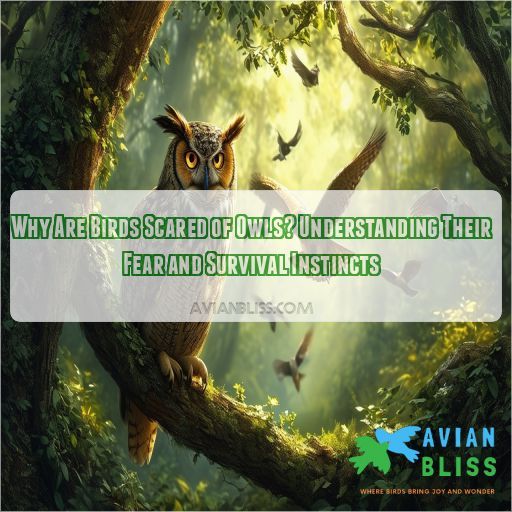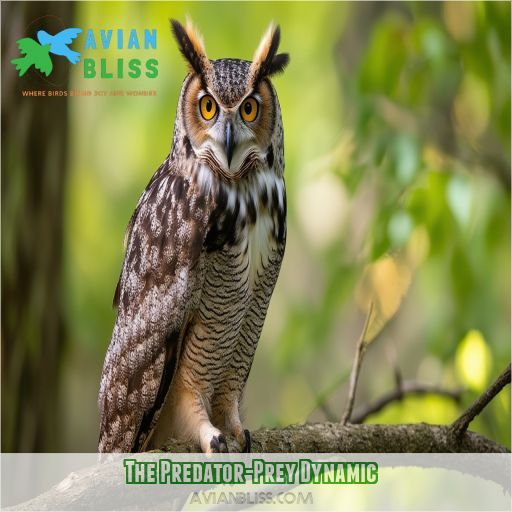This site is supported by our readers. We may earn a commission, at no cost to you, if you purchase through links.

Like a silent menace, owls represent the ultimate predator. They glide noiselessly, their sharp talons ready to snatch unsuspecting prey. It’s this predatory prowess that strikes fear into the hearts of many birds.
In understanding why birds are scared of owls, you’ll explore their survival instincts, evolutionary adaptations, and the critical role of fear in their lives.
Table Of Contents
- Key Takeaways
- Why Are Birds Scared of Owls?
- The Predator-Prey Dynamic
- The Importance of Fear Responses
- The Role of Visual Cues
- The Role of Auditory Cues
- The Role of Smell
- The Role of Habitat
- The Role of Social Structure
- Species-Specific Responses
- The Impact of Human Activity
- The Implications for Conservation
- Frequently Asked Questions (FAQs)
- Do birds get scared of owls?
- Do fake owls really keep birds away?
- Do birds not like owls?
- What animals do owls scare away?
- Can fake owls be used to scare away birds effectively?
- How do birds react to owl decoys in urban areas?
- Are some bird species immune to owl fear responses?
- Can owl sounds be used to deter birds from gardens?
- Do birds develop a tolerance to owl scare tactics over time?
- Conclusion
Key Takeaways
- Birds’ fear of owls is deeply rooted in survival instincts and evolutionary adaptations, driving them to develop heightened sensory abilities and agile responses to avoid becoming prey.
- The predator-prey dynamic between owls and birds represents nature’s delicate balance, with owls’ stealthy hunting techniques and birds’ acute fear responses contributing to the overall environmental equilibrium.
- Birds’ visual, auditory, and olfactory cues, as well as their social structures, habitat, and species-specific behaviors, all play vital roles in their fear of owls and their strategies for survival.
- Human activity significantly impacts bird behavior, highlighting the importance of conservation tactics and habitat preservation to maintain essential fear adaptations in birds.
Why Are Birds Scared of Owls?
Birds possess several traits that contribute to their fear of owls. These include:
- Evolved Instincts and Survival Mechanisms
- Perception of Threat from Owls
- Formidable Predators
- Silent Flight
- Night Vision
- Piercing Gaze
The Predator-Prey Dynamic
The predator-prey dynamic between owls and birds represents nature’s exquisite harmony. Owls, acting as nocturnal hunters, have evolved unique attributes including quiet flight and remarkable night vision, providing them with a hunting advantage. Such features allow them to detect prey with minimal effort and maximal stealth. Conversely, numerous birds have sharpened their visual and auditory senses to perceive this hushed danger and respond promptly. This intricate dance of predator stealth and prey detection mechanisms fosters environmental equilibrium by maintaining population levels naturally.
When an owl dives soundlessly, birds’ instantaneous reaction reflects a fundamental survival strategy, keeping them alert and nimble in their struggle for existence.
The Importance of Fear Responses
Fear responses in birds are essential for their survival. When birds recognize owls as predators, they experience a cortisol release, heightening their alertness. This hormonal surge enables quick decisions, especially for fledglings who are more vulnerable.
Panic triggers include sudden noises or movements, sparking predator recognition. Birds often learn aversion through experience, associating owls with danger. The impact of noise also plays a significant role, as loud sounds can mimic predator threats.
To further understand these responses, consider these key points:
- Cortisol Release: Heightens alertness, aiding in rapid escape.
- Fledgling Vulnerability: Young birds are more susceptible to panic.
- Panic Triggers: Sudden movements or noises induce fear.
- Learned Aversion: Birds associate owls with danger through experience.
The Role of Visual Cues
Birds perceive owls as threats due to their piercing gaze and formidable size, which instinctively triggers their fear responses. Over evolutionary time, birds have adapted to recognize and avoid owls, essential for their survival.
Perception of Owls
Birds recognize owls as predators through their piercing gaze, formidable size, and silent flight. Owls’ night vision allows them to hunt in dim light, creating a sense of unease for birds. Silent flight lets owls approach without warning. This makes birds, with their species-specific response and dependence on visual cues, flee to stay safe within their habitat.
Evolutionary Adaptations
You’ve seen how birds perceive owls as threats, but have you ever wondered why? It’s all about evolutionary adaptations. Over millions of years, birds have developed instinctive behaviors to survive owl predation. These adaptations are hardwired into their genetic programming, making fear of owls an effective survival strategy.
Here are some key evolutionary adaptations:
- Heightened visual acuity for detecting owl silhouettes
- Rapid flight responses triggered by owl-like shapes
- Enhanced hearing to pick up subtle owl sounds
- Social alarm calls to warn flock members
- Nesting strategies to minimize owl predation risks
The Role of Auditory Cues
You might think birds rely solely on their eyes to spot predators, but their ears play a vital role too. Owls, being nocturnal hunters, have mastered the art of acoustic mimicry to lure unsuspecting prey. Birds have evolved impressive sound localization abilities and frequency sensitivity to detect these predator calls. When they hear an owl’s distinctive hoot, it triggers their survival instincts, causing them to emit alarm calls that warn others of the danger.
Vocalization patterns among birds vary, but they all share a common language regarding threats. Conservation efforts often use this knowledge, employing noise deterrents to keep birds away from hazardous areas. However, loud noises can disrupt ecosystems, so it’s a delicate balance.
Next time you’re outside, listen closely. You’ll hear a symphony of bird calls, each with its own meaning in the avian world of survival.
The Role of Smell
You might be surprised to learn that birds’ sense of smell plays a role in their fear of owls. While not as developed as their visual and auditory senses, some birds can detect chemical cues left by predators, including owls, which can influence their behavior and survival strategies.
Olfactory Receptors
You might be surprised to learn that birds have a keen sense of smell. Their olfactory receptors play a vital role in detecting chemical signals in their ecosystem.
These receptors have evolved to help avian species identify potential threats, including owls. While not as developed as some mammals, birds’ smell receptors are finely tuned to pick up strong odors, unfamiliar objects, and even subtle changes in their environment.
This enhanced sense of smell contributes to their survival instincts.
Pheromones
You’ve learned about olfactory receptors, but did you know that pheromones play a significant role in bird-owl interactions? These chemical signals can communicate key information:
- Alert of predator presence
- Indicate reproductive status
- Mark territorial boundaries
- Express stress levels
- Direct migration navigation
Although birds aren’t recognized for their sense of smell, some species can detect pheromones from owls. This capability assists them in avoiding nest predation and staying safe from these secretive hunters. Even artificial owls with authentic appearances can activate these innate responses.
Behavioral Impact
Now let’s explore how smells affect bird behavior around owls.
An increased vigilance kicks in due to altered flight paths and avoidance tactics. Roosting and nesting patterns change too.
Communication takes new forms through warning signals. Surprisingly, reactions vary across bird families based on appearance and sudden movements.
While plastic owls might help initially, remember that variability exists in their effectiveness.
The Role of Habitat
Your bird’s habitat plays a vital role in its fear responses, especially in relation to predators like owls. Habitat fragmentation and urban encroachment disrupt natural nesting sites, creating artificial landscapes that increase exposure to predators. Harsh weather and climate change can also force birds into less protected areas, heightening their vulnerability. In fragmented habitats, birds lack ample cover, making them more susceptible to predation. Reflective materials and other artificial elements may confuse birds, adding to their stress levels and reducing their ability to detect threats. To better attract and protect birds:
- Preserve and restore natural habitats to minimize fragmentation.
- Avoid excessive urban encroachment on bird nesting areas.
- Implement measures to mitigate climate change impacts on bird habitat.
The Role of Social Structure
Birds’ social structures play an essential role in their response to owls. Flock dynamics enhance safety as birds share the task of keeping watch. When an owl is spotted, group defense mechanisms kick in, with birds collectively mobbing the predator to drive it away.
Social learning enables birds to recognize and react to owls’ threat cues quickly. Territorial behavior also influences reactions—birds familiar with their environment can better identify and respond to predators.
Interspecies interactions amplify these behaviors, as different bird species often collaborate to fend off shared predators. Understanding these social dynamics is crucial for complete bird control and determining effective bird deterrents and physical barriers in wildlife removal strategies.
Species-Specific Responses
You may have noticed that not all birds react the same way to the presence of owls. That’s because species-specific responses can vary quite a bit.
Smaller songbirds, for instance, are more likely to engage in "mobbing" behavior – swarming and harassing the owl as a group defense strategy.
Meanwhile, ground-feeding birds tend to be more vigilant and wary, keeping a close eye out for any aerial predators.
And some birds, like the red-breasted nuthatch, seem to be less fazed by fake owls than others.
It all comes down to the unique evolutionary adaptations and ecological niches of each species. Understanding these nuances can help you deploy the most effective deterrents for your feathered foes.
The Impact of Human Activity
Having explored species-specific responses, let’s shift to how human activity impacts bird behavior. Human presence can greatly alter birds’ reactions to natural predators like owls.
- Disturbed habitats force birds into closer proximity with people and other predators.
- Agriculture impact reduces available natural food sources and nesting sites, pushing birds in the direction of urban areas.
- Urban expansion creates environments where birds face additional threats and competition.
- Human noise, from traffic to construction, distracts and stresses birds, impairing their predator detection abilities.
- Habitat fragmentation, resulting from roads and buildings, leaves birds with fewer safe spaces, making them more vulnerable.
Understanding these effects highlights the vital role humans play in shaping bird responses and survival strategies.
The Implications for Conservation
Understanding the implications for conservation can help effectively manage bird populations. Fear adaptations and predator interactions drive many conservation tactics. Implement deterrence methods to minimize human impact and encourage safer environments. Integrate habitat protection and restoration efforts to support both prey species and owls. Regularly monitoring species behavior and implementing conservation tactics based on these observations is essential.
| Aspect | Conservation Tactics | Outcome |
|---|---|---|
| Habitat Restoration | Create safe spaces | Improved breeding and survival |
| Predator Management | Implement deterrence methods | Balanced ecosystems |
| Species Monitoring | Regular population checks | Early detection of threats |
| Education Programs | Raise awareness | Encourage public support for conservation |
Protecting natural habitats and reducing urban development disturbances can preserve essential fear adaptations in birds.
Frequently Asked Questions (FAQs)
Do birds get scared of owls?
You’re wondering if birds get scared of owls? Yes, they do! Many bird species fear owls, which is why fake owls can be effective deterrents, especially against songbirds, to keep them away from certain areas.
Do fake owls really keep birds away?
You can use fake owls to deter birds, as they’re often effective against species like songbirds. However, combining them with other methods, such as sound devices or physical barriers, can lead to better results.
Do birds not like owls?
You might wonder why birds are scared of owls. It’s simple: owls are natural predators with sharp talons, a formidable presence, and silent flight, making them a genuine threat that birds instinctively fear.
What animals do owls scare away?
Owls can scare away animals such as small mammals like mice and voles, other birds like songbirds and woodpeckers, and sometimes even larger animals like rabbits. The key is their predatory nature and stealthy approach.
Can fake owls be used to scare away birds effectively?
You can use fake owls to scare away birds effectively, especially by placing them in problem areas and moving them regularly. However, combining them with other deterrents will maximize their effectiveness.
How do birds react to owl decoys in urban areas?
In urban areas, birds initially react to owl decoys with fear, often avoiding the location. However, they may become accustomed to static decoys over time, reducing their effectiveness unless regularly moved or combined with other deterrents.
Are some bird species immune to owl fear responses?
Even the best-laid plans can fall apart; some bird species, like certain pigeons and woodpeckers, can become acclimated to decoy owls, rendering them ineffective. Adapting your methods can boost deterrent success.
Can owl sounds be used to deter birds from gardens?
Using owl sounds can effectively deter birds from gardens. Birds, instinctively fearing owls as predators, may avoid areas where these sounds are played, creating a safer and bird-free environment for your plants and vegetables (Source).
Do birds develop a tolerance to owl scare tactics over time?
Birds can develop a tolerance to owl scare tactics over time, often growing accustomed to fake owls or sounds if they’re not moved or combined with other deterrents, thereby reducing their effectiveness (Source).
Conclusion
Understanding why birds are scared of owls involves examining their survival instincts and predator-prey dynamics.
Birds rely on visual and auditory cues, smell, and their habitat to detect and avoid owls. Their evolutionary adaptations and fear responses are vital for survival.
You will find that social structures and species-specific behaviors also play significant roles.
Human activity impacts these dynamics, offering insights for conservation efforts.
This knowledge helps you appreciate the intricate balance of nature and predator-prey relationships.













